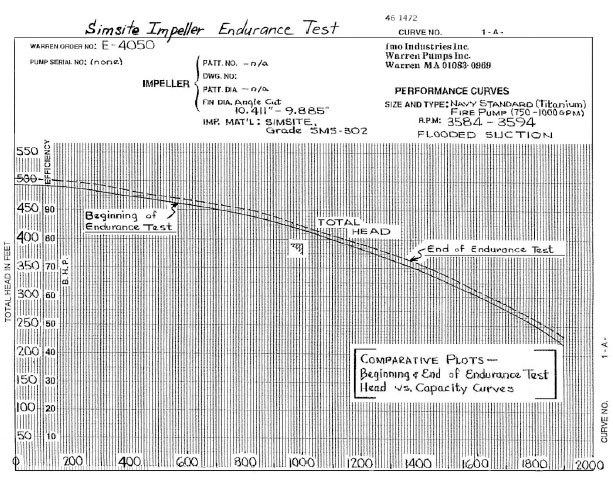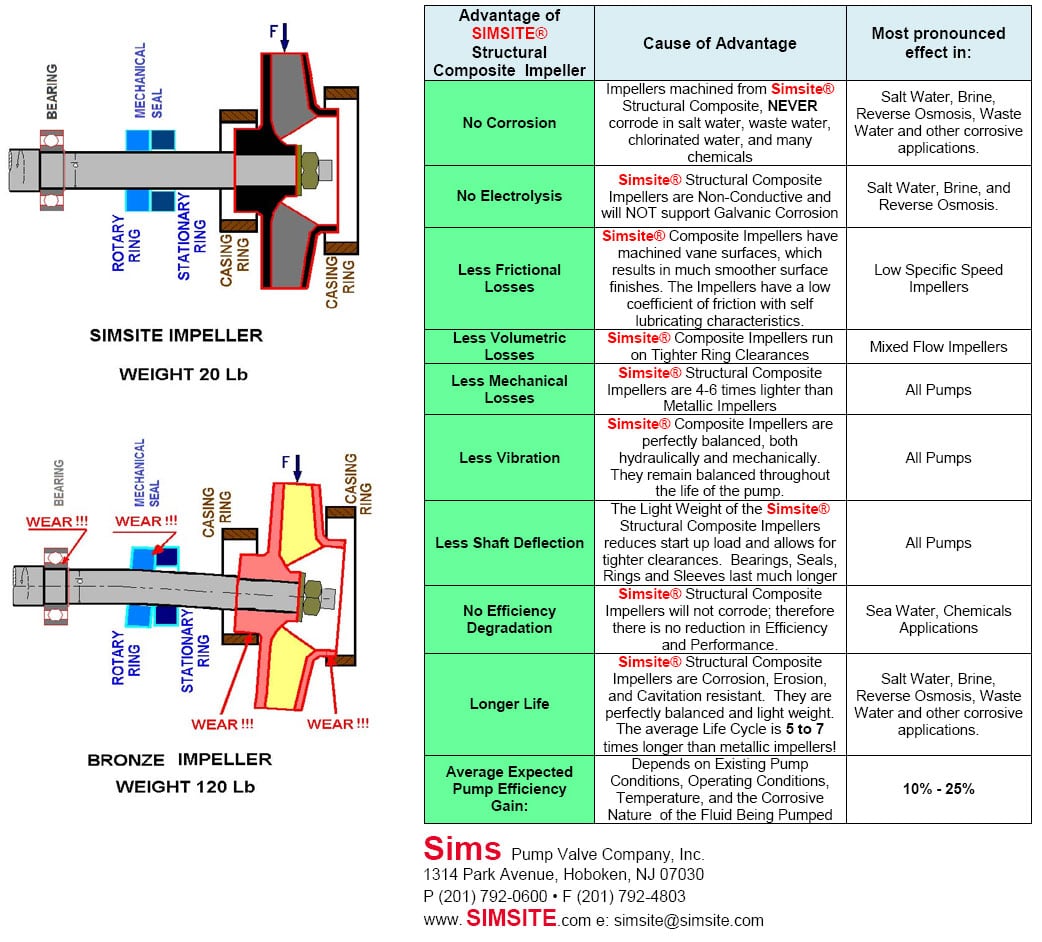

Wear between the rings and bushings create large clearances, which result in substantial decreases in pump efficiency, as well as huge increases in the energy consumed to operate the pump. Historically, most pump companies, and repair facilities have used metallic parts for Wear Rings, Casing Rings, Sleeves, Bushings, and Guide Bearings. These metallic parts have the potential to gall and seize, and therefore, require larger clearances between the parts. Compounding the issue is that these metallic parts do not have self lubricating qualities like many composites, and metallic parts are always subject to corrosion which further increases clearances and energy consumption.
Fortunately, today there are excellent solutions to these problems. In recent years, thermoplastic and thermoset engineered composites have been used very successfully to replace these obsolete metallic parts. Thermoset Structural Composites (A structural composite is one in which the fibers are not chopped, cut, or macerated) like SIMSITE® manufactured by SIMS have the mechanical strength of metal, and have self-lubricating qualities embedded in the composite eliminating the risk for seizing and galling. Furthermore, these engineered composites have extremely smooth surfaces with an excellent surface finish and a low coefficient of friction on all surfaces, which increases efficiency and reduces energy consumption.

As you can see from the above graph, most composites have a lower coefficient of friction than the traditional metallic materials; (Bronze & Stainless Steel) that have been used in pumps. Structural Graphite Composites and Engineered Composites have the lowest coefficient of friction – lubricated or non-lubricated. The low coefficient of friction reduces the friction losses of the liquid being pumped, which allows for an increase in efficiency and a reduction in energy consumption.

Simsite® Structural Composites are impervious to different corrosive environments, these composite wear components will not corrode, or erode like metallic components. Although composite wear components will reduce energy consumption for all pumps, including all fresh water services, the greatest savings will occur in corrosive environments such as salt water, waste water, chlorinated water, and chemical process, because the composites are corrosion resistant and in many cases will not corrode at all.
When the metallic pump parts begin to wear from corrosion, pump efficiency drops drastically. This drop in efficiency not only has a significant impact on Energy consumption, but it also significantly increases the cost of maintenance, repairs, and overhauls. The life cycle of the pump is often reduced to months instead of years.
Corrosion Resistance Chart:
As you can see from the above chart, Composites do not corrode in Salt Water, or Waste Water, and are excellent with chemicals that are compatible with the composite.


Engineered Structural Composite Simsite® Impellers offer an even greater potential to reduce energy consumption. Because of their corrosion, erosion, & cavitation resistance, light weight, smooth vane passageway surfaces, and anti-galling & seizing characteristics, composite impellers are able to operate at significantly higher efficiencies than metallic impellers reducing energy costs and consumption.
Structural Engineered Composite Impellers, like SIMSITE® Impellers & Rings, offer even greater savings, because they are machined as opposed to being cast or molded. Machining enables the composite impeller to be optimized hydraulically for the service in which the pump is running. Machining allows for perfect balance, both mechanically and hydraulically, because of the accuracy of the vane passages. Since these impellers are corrosion resistant to most liquids, they do not go into an imbalance even after years of service! This reduction in vibration translates into higher efficiency and a reduction in energy consumption.


According to the U.S. Department of Energy (DOE), many centrifugal pumps may be less than 50% efficient but have the potential to improve by 20-30% through various upgrades and system changes. Pump Upgrades not only improve performance, maintenance and repair issues, but they also improve efficiency as well, so they will extend pump life and reliability. Pump Upgrades prevent expensive products from deteriorating; they can even prevent pump leaks that can result in costly cleanups and fines from regulatory agencies. In most cases, reduced downtime eliminated by the pump upgrade outweighs all other benefits.
In difficult times, it may be hard to allocate the funds for the upgrades, but the payback for doing pump upgrades is extremely quick. The resulting savings from the upgrades frees up funds that otherwise would have been wasted on energy, and more expensive repairs at a later date. In almost all cases, the incremental costs of upgrades are minimal when compared to the loss in downtime and expensive repairs.
Plant Outages, Ship Overhauls, Building New Vessels, Building New Manufacturing Plants, Plant Expansions, and New System Installations are good opportunities to specify pumps with upgraded efficiency and reliability features such as Simsite® Structural Graphite Composite Pump Internals (Impellers, Casing Rings, Sleeves, Bushings, Bearings, and Mechanical Seals).

The above graph shows that changing the Bronze Impeller to a Simsite® Structural Composite Impeller increased efficiency 15.8%! The efficiency on this 20 KW pump (26.8 HP) went from 57% with a metallic impeller to 66% with a structural composite impeller – an increase of 9 points or 15.8%! At 0.11 cents per kilowatt hour this translates into a yearly savings of $2,218.00 per year, per pump! After only 1 year of service in a corrosive environment such as salt water, the metallic impeller, which was originally bronze, begins to corrode, which further reduces efficiency. Depending on the service, and the temperature of the salt water, and how the pump was operating, the efficiency will be reduced by as much as 5% to 7%, or more, resulting in additional energy costs! Upgrading to a Simsite® Structural Composite Impeller will not only increase efficiency 15.5% from the start, but will also prevent the losses in efficiency as a result of corrosion resulting in a total saving to the Customer of more than 20%! This results in a yearly savings of $4,155.00 per year per pump!


Simsite® Impellers and Rings are the new alternative composite solutions for new, repair, or retrofit pump applications. They are light weight and virtually indestructible. Wear of other pump parts including the pump casing are greatly reduced, because of the Impeller's perfect balance, light weight, self-lubricating, sealing, and corrosion, erosion, & cavitation resistance. This means far less expense for replacement of parts, downtime, and years of trouble free performance. When you reduce or eliminate corrosion, erosion, and cavitation, you automatically increase efficiency and substantially reduce energy efficiency and costs.

It is an all too common problem – You purchased a pump for one specific performance and when you put the pump into service in your plant, or ship, the pump operates at another point completely different from the original design point (BEP – best efficiency point) of the pump because of your system requirements. In addition to being very inefficient, when you operate the pump away from the original design point or BEP, it causes a multitude of problems. These problems include excessive noise & vibration of the pump, shaft oscillation, cavitation, premature wear and failure of the mechanical seals, bearings, rings, sleeves and impellers. In extreme cases, the pump shaft will break.


Because of the self lubricating characteristics of many engineered composites, and because composites do not wear, or corrode, like metallic pumps, the performance curve will actually increase over a period of time. The chart below shows test performed by Warren Pumps on a US Navy Standard Fire Pump manufactured from Titanium. A 1000 hour performance test was performed with a SIMSITE® Engineered Structural Composite Impeller and Casing Rings. The result clearly showed a substantial increase in the H-Q (Head-Capacity) Curve – 2.5% with the SIMSITE® Composite Impeller and Rings at the end of the 1000 hour Endurance Test.

The Impeller is the heart of any Centrifugal Pump. Like a human heart, a pump impeller is the most loaded pump component, constantly stressed by hydrodynamic forces, fatigue, corrosion, erosion abrasion, chemical attack, and cavitation.
The overall Efficiency of a Centrifugal Pump is in direct correlation to the Efficiency of the Impeller. The Impeller's hydraulic design must correspond to the hydraulic design of the pump Casing and to the Operating Conditions of the pump in service (In the Plant) in order to maximize efficiency.
Companies like SIMS in Hoboken, N.J. specialize in the designing, engineering, and the manufacturing of Premium Efficiency Structural Composite Simsite® Impellers, and Pumps. Any Centrifugal Pump fit with the Premium Efficiency Simsite® Structural Composite Impeller will save a tremendous amount of money for the Pump Owner and Operator in Repair and Maintenance Costs as well as in Energy Consumption. This saving comes from Electrical Saving, (a higher efficiency pump consumes less energy), and from Savings on Maintenance and Repair (the pump fitted with a SIMSITE® Impeller will have a much longer life and a smoother run time), because the Simsite® Structural Composite Impellers will never corrode.


Because the new alternative Simsite® structural composite Impellers are computer engineered, designed, and precision machined, the impeller vane geometry can be engineered utilizing CFD (Computerized Fluid Dynamics) techniques and programs to maximize efficiency and performance. Problems such as recirculation, radial thrust, and cavitation can be minimized, or eliminated, by using structural composite impellers instead of the traditional metallic ones. Impeller vane shapes can easily be modified to provide the best vane shape for specific applications and performance requests.

Another critical area where Simsite® composites significantly help in the reduction of Energy Consumption and Repair and Maintenance is in the area of shaft deflection. Simsite® Structural Composites Impellers & Casing Rings, manufactured by SIMS, are only 15% the weight of traditional metallic materials. The lower weight not only reduces start-up load, but also reduces shaft deflection, which allows the rotating element to run with tighter clearances between the rings and the impeller. The tighter ring clearance reduces leakage, which increases efficiency and reduces energy consumption. The reduction in shaft deflection reduces vibration, and increases efficiency. The reduction in shaft deflection enables bearings, sleeves, mechanical seals, and rings to last much longer which saves on repair and maintenance costs.
1/6 The Weight of Bronze.
Less Shaft Deflection F = M * Ac
Less Start Up Load y = WL2 / CEI
y = deflection, in ; W = weight of rotating element, lb ; L = shaft span, in;
A = acceleration; c = coefficient depending on shaft-support method and loading;
E = modulus of elasticity of shaft material, lb/in2 ; I = moment of inertia (pD4/64), in4
